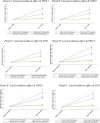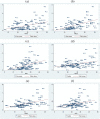Understanding the heterogeneity of COVID-19 deaths and contagions: The role of air pollution and lockdown decisions
- PMID: 34998067
- PMCID: PMC8714297
- DOI: 10.1016/j.jenvman.2021.114316
Understanding the heterogeneity of COVID-19 deaths and contagions: The role of air pollution and lockdown decisions
Abstract
The uneven geographical distribution of the novel coronavirus epidemic (COVID-19) in Italy is a puzzle given the intense flow of movements among the different geographical areas before lockdown decisions. To shed light on it, we test the effect of the quality of air (as measured by particulate matter and nitrogen dioxide) and lockdown restrictions on daily adverse COVID-19 outcomes during the first pandemic wave in the country. We find that air pollution is positively correlated with adverse outcomes of the pandemic, with lockdown being strongly significant and more effective in reducing deceases in more polluted areas. Results are robust to different methods including cross-section, pooled and fixed-effect panel regressions (controlling for spatial correlation), instrumental variable regressions, and difference-in-differences estimates of lockdown decisions through predicted counterfactual trends. They are consistent with the consolidated body of literature in previous medical studies suggesting that poor quality of air creates chronic exposure to adverse outcomes from respiratory diseases. The estimated correlation does not change when accounting for other factors such as temperature, commuting flows, quality of regional health systems, share of public transport users, population density, the presence of Chinese community, and proxies for industry breakdown such as the share of small (artisan) firms. Our findings provide suggestions for investigating uneven geographical distribution patterns in other countries, and have implications for environmental and lockdown policies.
Keywords: COVID-19 pandemic; Economic activity; Lockdown; Particulate matter.
Copyright © 2021 Elsevier Ltd. All rights reserved.
Conflict of interest statement
The authors declare that they have no known competing financial interests or personal relationships that could have appeared to influence the work reported in this paper.
We declare we have no conflicts of interest.
Figures









References
-
- Agosto A., Campmas A., Giudici P., Renda A. CEPS Working Document No 2020/03. 2020. Monitoring Covid-19 contagion growth in Europe.http://aei.pitt.edu/id/eprint/102672 March 2020.
-
- Aldrin M., Haff I.H. Generalised additive modelling of air pollution, traffic volume and meteorology. Atmos. Environ. 2005;39:2145–2155. doi: 10.1016/j.atmosenv.2004.12.020. - DOI

